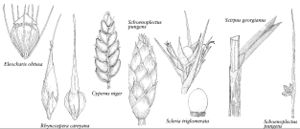Difference between revisions of "Cyperus"
Sp. Pl. 1: 44. 1753.
Gen. Pl. ed. 5, 26. 1754.
imported>Volume Importer |
imported>Volume Importer |
||
| Line 117: | Line 117: | ||
|publication year=1753;1754 | |publication year=1753;1754 | ||
|special status= | |special status= | ||
| − | |source xml=https:// | + | |source xml=https://bitbucket.org/aafc-mbb/fna-data-curation/src/2e0870ddd59836b60bcf96646a41e87ea5a5943a/coarse_grained_fna_xml/V23/V23_225.xml |
|genus=Cyperus | |genus=Cyperus | ||
}}<!-- | }}<!-- | ||
-->[[Category:Treatment]][[Category:Cyperaceae]] | -->[[Category:Treatment]][[Category:Cyperaceae]] | ||
Revision as of 20:39, 5 November 2020
Herbs, perennial or less often annual, cespitose or not, rhizomatous, stoloniferous, rarely tuberous. Culms solitary or not, trigonous or round, glabrous or scabridulous with extrorse or antrorse (rarely retrorse) prickles. Leaves usually basal; ligules absent; blades keeled abaxially, flat, V-, or inversely W-shaped in cross section. Inflorescences terminal, rarely pseudolateral, 1st order subumbellate to capitate, 2d order with spicate or digitately arranged spikelets, rarely a solitary spikelet; spikelets 1–150; 1st order rays unequal (rarely equal) in length, produced singly from the axils of inflorescence bracts; involucral bracts 1–22, spirally arranged at culm apex, spreading to erect, leaflike. Spikelets: scales to 76, distichous, each subtending flower, cylindric to compressed, borne spicately or digitately at ends of rays (occasionally proliferous). Flowers bisexual [rarely unisexual], in axils of distichous floral scales, bases often decurrent onto rachilla as ± hyaline wings; perianth absent; stamens 1–3; styles linear, 2–3-fid, base deciduous or persistent; stigmas 2–3. Achenes biconvex, flattened, or trigonous.
Distribution
Pantemperate and tropical.
Discussion
Species ca. 600 (96 in the flora).
Selected References
Lower Taxa
Key
| 1 | Stigmas 2 (3 in C. serotinus); achenes biconvex. | > 2 |
| 1 | Stigmas 3; achenes trigonous, plano-convex, or terete. | > 3 |
| 2 | Achenes laterally flattened, borne with edge toward rachilla. | Cyperus subg. Pycreus |
| 2 | Achenes dorsiventrally flattened, borne with face toward rachilla. | Cyperus subg. Juncellus |
| 3 | Spikelets borne in digitate clusters (rarely singly) or in umbellate or glomerulate heads. | Cyperus subg. Pycnostachys |
| 3 | Spikelets borne in spikes on conspicuous rachis. | > 4 |
| 4 | Rachilla continuous or articulate only at base. | Cyperus subg. Cyperus |
| 4 | Rachilla articulate at base of each scale, mature spikelet disarticulating into segments consisting of scale, internode, and rachilla wings. | Cyperus subg. Diclidium |
